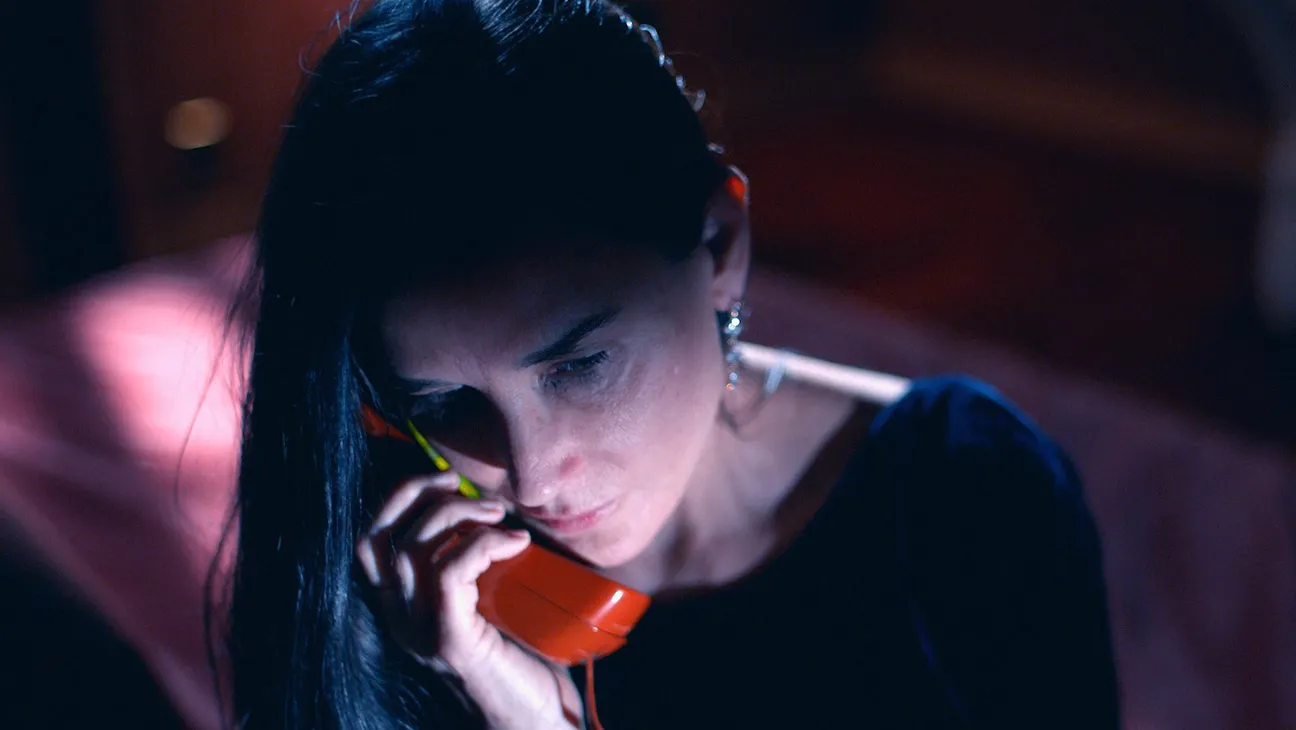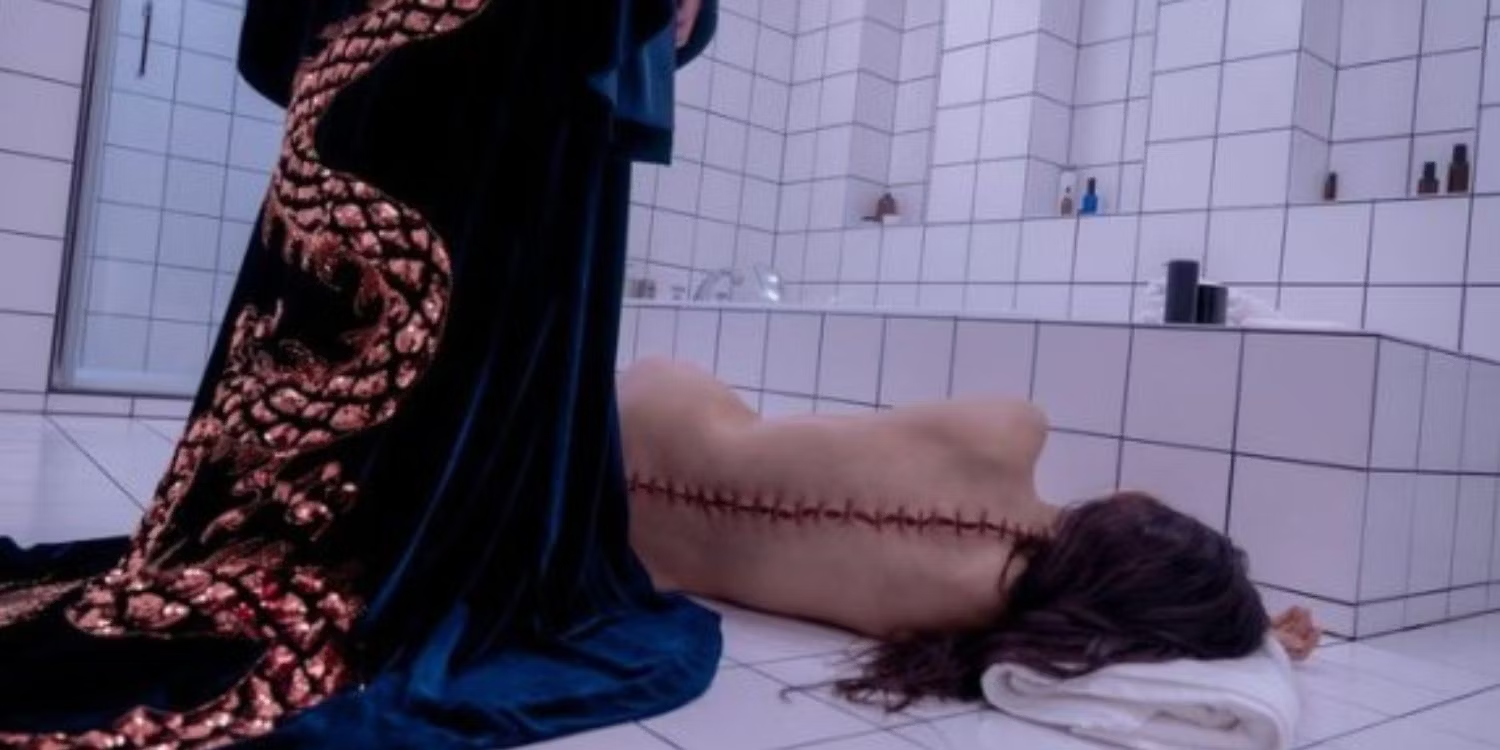Tales of the cost of finding a fountain of youth are hardly new. That goes for double for modern takes on the story that uses Hollywood as their setting, treating the talent like grits for the industry mill. But The Substance is a grotesque fairy tale told with such a giddy scuzz-bucket gusto that it reminded me of a big-screen Tales From the Crypt episode.
Written and directed by French filmmaker Coralie Fargeat, The Substance plummets the viewer into a visceral body horror that had me squirming in my seat and looking away from the screen. I loved nearly every second of it.

Fargeat’s last film, Revenge, which I also loved, was a rape-revenge movie that followed in a similar vein, filled with feminine fury. For The Substance, she’s traded the scorching oppressive heat of the desert for the omnipresent Los Angeles sun as it beats down on our heroine, aging starlet Elisabeth Sparkle (Demi Moore).
At 50, Elisabeth is considered over the hill. She loses her job and, in a desperate bid to maintain her relevance, finds herself opting for a new wonder drug. Only the drug doesn’t keep you young; it clones a younger version of yourself. Fargeat throws in a nice wrinkle in which the clone and the original, called the Food Matrix, must switch every seven days without exception.
Margaret Qualley plays the younger Elisabeth, who goes by Sue. The scene where Elisabeth births Sue, her back splitting open like some Lovecraftian horror emerging, is worth the price of admission. Between that scene and the final reel, Faegerat harkens back to the all-or-nothing days of pre-Lord of the Rings Peter Jackson.
She is a filmmaker who delights in exploring the fragility of the human body and wallowing in its nightmarish elasticity. One might call her a modern-day Cronenberg, but it’s too early to tell. Still, what is apparent is her prediction for clashing the bright, dazzling neon with the hot, bland lights of the outside. The Substance is a gorgeous film filled with stomach-churning filth.
The script won at Cannes, a rarity for horror films, and is scant. It’s less a story and more a fable, with Moore’s Elisabeth Sparkle mirroring Moore’s own trajectory in the business. The Substance seems to exist in a no-man’s land of time. Fargeat populates the film with modern tech but chooses aesthetics and attitudes from past decades.
For example, the hit show that Moore’s Elisabeth is the star of is a workout show. It’s the kind of show reminiscent of Suzanne Sommers and Shirley McClaine, showcasing Elisabeth’s toned physique more than demonstrating how to be fit.
The show’s sleazy producer, Harvey (Dennis Quaid), wants Elisabeth fired because she’s old. The aesthetics are all 80s neons, the attitude is 100% 90s, and the tech is all modern, giving The Substance an unmoored feeling like we’ve entered a funhouse where everything is recognizable but not the same.
Still, as much as I loved The Substance, I couldn’t help but wish we knew just a little more about Elisabeth or Sue. There’s very little dialogue for almost two and a half hours, with Fargeat using sound and silence and Raffertie’s unnerving throbbing synth score.
However, the shallowness of Elisabeth and Sue is part of the point. Despite the horrific abomination she becomes, it’s nothing compared to the monster of vanity and self-loathing of Elisbaeth and Sue. The two are constantly reminded by the mysterious voice on the phone that “they are the same,” but Elisabeth is such a selfish, vain-glorious bitch she can never seem to wrap her head around it.

The Substance works so well because of Moore and Qualley. Moore likely channeled more than a little of her experience into the aging and mistreated Elisabeth. After all, Moore became famous during a period in which The Substance seemed more documentary than fiction. An actress like Megan Fox is more famous for her beauty than her talent, and like so many famous beautiful actresses from that time, she is only now getting her flowers.
Moore throws herself into Elisabeth Sparkles. In Moore’s hands, we see remnants of a personality all but erased by self-loathing and a hunger to be adored-not loved. Like an old-school Universal monster, she is a tragic figure who breaks our hearts while making us look away.
One scene has Moore’s Elisabeth calling the number of an old classmate for a date. She wears a slinky dress and makeup but can’t leave the apartment because she keeps seeing the flaws. The flaws only seem magnified when compared to her younger self. The scene resembles Travis Bickle calling Cybil Shepherd in The Taxi Driver, where you wish Benjamin Krancun’s camera would look away. Still, the pain and the hurt are too much to witness despite the monster exhibiting them.
Qualley’s Sue is a hedonistic Hyde to Moore’s tragic Jekyll. Relishing in the attention her looks garner, she takes pride in embodying male dreams. Like Elisabeth, she confuses desire with love but is blinded by her ravenous appetite for adoration. Donning prosthetic breasts, Qualley channels a younger Moore as she preens and eagerly puts on skimpier spandex.
Sue is given a second chance, and it seems she’s making all the same bad decisions that led to Elisabeth’s almost recluse-like present. Basking in Harvey’s praise and heedless of consequences, Qualley’s Sue is as vile as she is gorgeous, with little regard for her older ‘food matrix.’
Amidst all this, Fargeat explores how we hate ourselves, how careless we are in our youth, and how our decisions often have far-reaching consequences. Elisabeth hates Sue, not because she is young and pretty, though it’s part of it, but because she seems to be doing the same thing she did. Like an abusive cycle, she cannot break free. Likewise, Sue hates Elisabeth because she’s a reminder that she will not stay young forever, though she’ll be damned if she doesn’t try.
Fargeat’s editing emboldens the theme of The Substance, which depicts women being treated like flesh on an auction block in Hollywood. Along with co-editors Jerome Eltabet and Valentin Feron, The Substance uses the preparation and eating of food as visual parallels for how women are treated. The violence against flesh is often mirrored in how a chicken is gutted or stuffed, all the while Qualley is reaching inside her stomach for a drumstick.
The Substance is peppered with enough shots of firm, barely clad buttocks that it’s either a fetish or a point she’s trying to hammer home. Or attempt to work around the MPAA’s puritanical standards. The nudity and flesh on display are gorgeously filmed, but it feels unsettling through Kracun and Farfeta’s lens. The way they cut from smiling faces to unblinking eyes shows the void in Elisabeth and Sue’s souls as they long for the approval of a faceless mass.

The only real fly in the ointment is a fight that erupts between Sue and Elisabeth, in which they seem to have superhuman strength as they toss each other about. Labored metaphor aside, I’m inured to this fight, thanks to comic book movies.
However, the creature that resembles the castoff of The Island of Dr. Moreau, which appears in the third reel, had me right back in it. The creature design is grotesque, keeping with the rest of the film. But there’s attention to detail regarding one of the faces on the creature, which is the stuff of nightmares. The final scene was a mixture of sad, comedic, and disgusting, and it felt like the best possible way to end it.
It’s tempting to call The Substance shallow. But that would be missing the point. Fargeat isn’t aiming for some deep meditative look at a theme so much as she ripping the scabs off and forcing the puss out of an open wound.
Images courtesy of Mubi
Have strong thoughts about this piece you need to share? Or maybe there’s something else on your mind you’re wanting to talk about with fellow Fandomentals? Head on over to our Community server to join in the conversation!

